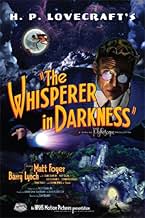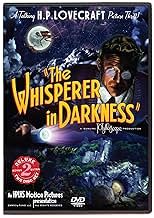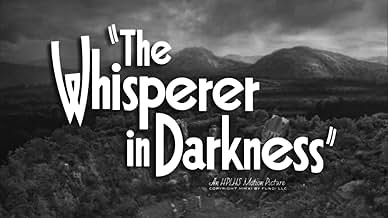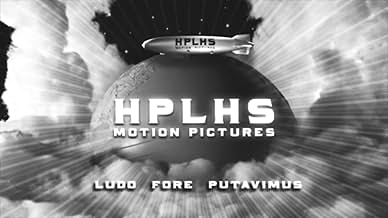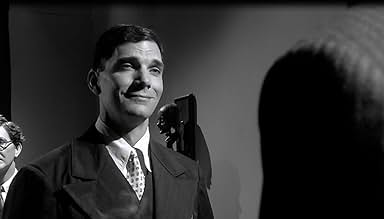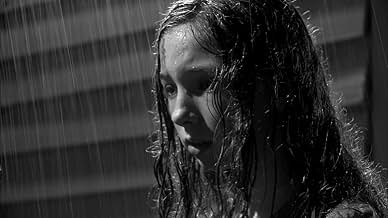IMDb RATING
6.5/10
3.8K
YOUR RATING
Based on the H. P. Lovecraft story of the same name, a folklorist investigates reports of unusual creatures in Vermont only to uncover more than he bargained forBased on the H. P. Lovecraft story of the same name, a folklorist investigates reports of unusual creatures in Vermont only to uncover more than he bargained forBased on the H. P. Lovecraft story of the same name, a folklorist investigates reports of unusual creatures in Vermont only to uncover more than he bargained for
- Director
- Writers
- Stars
- Awards
- 3 nominations total
Conor Timmis
- Porter
- (scenes deleted)
- Director
- Writers
- All cast & crew
- Production, box office & more at IMDbPro
Featured reviews
I saw almost everything whats's been done in term of so called "Lovecraft Cinema". From '63 The Haunted Palace , through '85 Re-Animator and 2005 Call Of Cthulhu. This is by far one of the best Lovcraftian adaptations. It really holds the right spirit of both his books and early 50-ties sci-fi cinema. If you're looking for speedy CGI action - forget about this one. If you're into Edgar Allan Poe books, '31 Frankenstein or '56 Forbidden Planet and know at least who Lovecraft is you should definitely see this. Decent acting, good script filmed with the right pace and an old-school production. A perfect alternative for these days cinema. Highly recommended!
One cannot help but give full marks to the H.P. Lovecraft Historical Society for their efforts to bring H. P. Lovecraft's eerie stories to the screen in a manner in keeping with the texture and mood of the original material. Although there have been other attempts to film Lovecraft stories, most have generally been unsatisfying failures due to misguided attempts to modernize or glamorize them. Not so with HPLHS, who have gone out their way to keep faithful to the period and locales in which the tales were set, even going so far as give the film the feel of an early-1930s black-and-white movie. Even their logo is an homage to the the old Universal Studios logo of the early 1930s (the studio which produced such classic horror movies as Frankenstein, Dracula and The Mummy), replacing the familiar airplane-circling-the-earth with a dirigible.
The plot involves Albert Wilmarth, a college anthropology professor specializing in folklore, who becomes intrigued by a series of unusual newspaper stories reported from a rural part of Vermont after a period of particularly heavy rains. It seems that bodies have been observed washing down from the mountains in the swollen rivers, bodies which are, reportedly, neither human nor animal. The bodies apparently also recall, among the older inhabitants, old tales of strange beings that live in remote parts of the hills, beings that are neither human nor animal, and possibly not even of terrestrial origin. Wilmarth begins his investigation into these stories on the basis that they are nothing more than mere interesting folklore, but soon finds himself dealing with something far more sinister.
Admittedly, the producers of the movie added some material and characters not present in the original story. In fact, the short story actually ends at a point only about one hour into the film. However, the original version was, after all, only a short story, and I suppose the makers felt that they had to add some material to the plot in order to expand the short story into a full-length movie. nevertheless, the movie still does a far better job of evoking the feel of H.P. Lovecraft's writing than any other movie versions of his works, with the only possible exception being the resent silent film version of The Call of Cathulhu, which was made by the same producers.
One addition to the film is a debate staged between the protagonist, Professor Wilmarth, and Charles Fort. While that was not a part of H.P. Lovecraft's original story, it is interesting period touch because Charles Fort was actually a real person, a celebrated and controversial author of the early 1900s who was known to contemporaries as "The Mad Genius of the Bronx". Fort, who died in 1932, wrote about what are now called paranormal phenomena before that term was even invented, and is credited, among other things, with coining the word "teleportation".
The plot involves Albert Wilmarth, a college anthropology professor specializing in folklore, who becomes intrigued by a series of unusual newspaper stories reported from a rural part of Vermont after a period of particularly heavy rains. It seems that bodies have been observed washing down from the mountains in the swollen rivers, bodies which are, reportedly, neither human nor animal. The bodies apparently also recall, among the older inhabitants, old tales of strange beings that live in remote parts of the hills, beings that are neither human nor animal, and possibly not even of terrestrial origin. Wilmarth begins his investigation into these stories on the basis that they are nothing more than mere interesting folklore, but soon finds himself dealing with something far more sinister.
Admittedly, the producers of the movie added some material and characters not present in the original story. In fact, the short story actually ends at a point only about one hour into the film. However, the original version was, after all, only a short story, and I suppose the makers felt that they had to add some material to the plot in order to expand the short story into a full-length movie. nevertheless, the movie still does a far better job of evoking the feel of H.P. Lovecraft's writing than any other movie versions of his works, with the only possible exception being the resent silent film version of The Call of Cathulhu, which was made by the same producers.
One addition to the film is a debate staged between the protagonist, Professor Wilmarth, and Charles Fort. While that was not a part of H.P. Lovecraft's original story, it is interesting period touch because Charles Fort was actually a real person, a celebrated and controversial author of the early 1900s who was known to contemporaries as "The Mad Genius of the Bronx". Fort, who died in 1932, wrote about what are now called paranormal phenomena before that term was even invented, and is credited, among other things, with coining the word "teleportation".
Really enjoyed the clean look of this film in black & white, and also the sound editing. This is probably the classiest example of what can be achieved with a limited budget when the filmmakers obviously have a love of the material which shines through. The script is faithful to Lovecraft yet it does cuts down on a lot of the excessive verbiage to make it somewhat more palatable to a modern audience. The pace progressively builds and does pay off. The standout performance is from the adorable Autumn Wendell "Hanna Masterson" who embodies the film and is very effective at being terrified, yet innocent at the same time. A perfect fit to a film which achieves the same things.
It is notoriously difficult to bring a Lovecraft story to the screens without reinventing pretty much everything. The reason for that is that the emotional tension in his stories is all based on what he tells you the characters feel. He doesn't really construct a horror environment as much as place people who are easily scared, disgusted or appalled in circumstances that are usually light sci-fi.
Created by the same team that did The Call of Cthulhu in 2005, it is a black and white movie, only this time not a mute one. The story it is based on is also longer, but then so is the movie.
I liked it, but then I kind of understand what H.P.Lovecraft was all about. For other people I think this would be a waste of time.
Created by the same team that did The Call of Cthulhu in 2005, it is a black and white movie, only this time not a mute one. The story it is based on is also longer, but then so is the movie.
I liked it, but then I kind of understand what H.P.Lovecraft was all about. For other people I think this would be a waste of time.
An adaptation of Lovecraft's story of the same name, which I have read. Within seconds, I pegged this as the work of the people who made The Call of Cthulu (director Brannery wrote and produced that film). I liked that one, but felt it was perhaps too slavish to a short story which didn't really lend itself that well to such a literal adaptation. The Whisperer in Darkness perhaps lends itself a lot better to such a treatment, and this adaptation is therefore quite good. It's been probably ten or eleven months since I read the story, so I don't remember it perfectly, but I think this is very faithful (the ending seems different, but I can't recall how the story ended that well). This is very creepy, with nice black and white photography. I don't much care for CGI monsters, but, for some reason, I think they look quite good in black and white, and the flying crab aliens look very good. The acting is amateurish throughout, but I did like Matt Foyer a lot in the lead. He has a great look for this movie. Highly recommended.
Did you know
- TriviaCharles Fort (1874-1932) was a real person, a collector of accounts of unusual phenomena, disdaining scientists who would try to explain it all away, as seen in the film.
- GoofsWhen Professor Wilmarth is waiting for young Mr. Akeley at the Boston train station, Wilmarth turns his head to see that the train is approaching. Although the image is out of focus, it is clearly a modern train, not one that would be seen in the 1920's.
- Crazy creditsAfter the FBI copyright warning: "all video involving fungal beings from the farther reaches of the solar system is carefully monitored by the Mi-Go, who deal harshly with those who duplicate and upload to the internet without permission."
- How long is The Whisperer in Darkness?Powered by Alexa
Details
- Release date
- Country of origin
- Official site
- Language
- Also known as
- 克蘇魯怪談:黑暗細語
- Production companies
- See more company credits at IMDbPro
- Runtime1 hour 43 minutes
- Color
- Aspect ratio
- 1.78 : 1
Contribute to this page
Suggest an edit or add missing content

Top Gap
By what name was The Whisperer in Darkness (2011) officially released in India in English?
Answer

